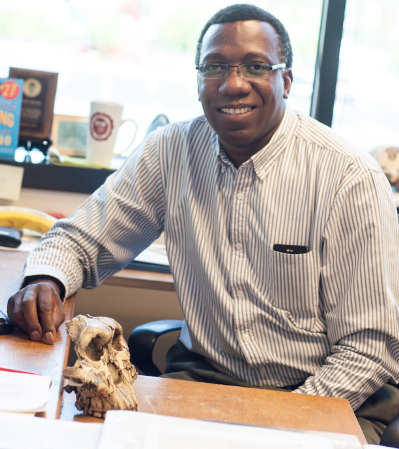|
Charles is a paleoanthropologist who has worked extensively at Olduvai Gorge and Laetoli in northern Tanzania since 1999. His research work on human origins focuses on reconstructing past environments (3.5 – 4.0 million years ago) using proxy data. He is actively involved in conservation and sustainable use of paleoanthropological resources not only to a small select group of people but to everybody in the world through education and cultural exchange programs. His previous work includes the evolution of upright posture and bipedal gait in humans with particular emphasis on the interpretation of the 3.5 million years old fossil hominid footprints from Laetoli in northern Tanzania. Charles has received numerous recognitions and fellowships including the Germany DAAD fellowship in 1983 and 1992, the Greek Demokritos Foundation fellowship in 1986, the Belgian VUBAROS fellowship in 1989, the British Council Visiting Scholar fellowship in 1991, the University of Chicago Century Scholar fellowship in 1993, the Japanese JSPS Visiting Scholar fellowship in 2004, and the Belgian Royal Museum for Central African Visiting Scholar fellowship in 2005. On top of securing over sixteen research grants and fellowships, Charles has written over forty five peer reviewed articles in paleoanthropological and archaeological journals and edited books. Charles is currently serving as a member of the International Council on Archaeological Heritage Management (ICAHM) scientific committee and a member of the Tanzania International Technical Committee that is helping Tanzania to build an on-site museum at Laetoli as a sustainable conservation solution for the 3.5 million years old hominid footprints. Charles has spearheaded a successfully funded proposal for two million Euros from the European Union (EU) to valorize Tanzania’s cultural heritage, he is extensively collaborating with the Ngorongoro Conservation Area Authority (NCAA). He is also a board member for a Denver based Africa School Assistance Project (ASAP) organization that builds schools in Tanzania. |
|
Recent discovery and naming of Homo naledi from the Dinaledi chamber in the Rising Star Cave system in South Africa offer us some new information on the evolution of the genus Homo in a way that is challenging us to reconsider what we know about our place in nature. The Dinaledi hominins are perhaps the most spectacular find the field of paleoanthropology has so far produced; their remarkable preservation, depositional history and morphological features provide us with some information that is helping us understand our complex evolutionary journey. Here I will share with you my personal reflection on the discovery and research on the Dinaledi hominins and how technology and social media is helping reshape the field of paleoanthropology. Tha National Geographic has a good background article on the cave (including an informative map) and the discovery of H. naledi. |

 Charles Musiba, PhD, is an associate professor of biological anthropology in the department of anthropology at the University of Colorado Denver. He is a native of Tanzania, born on the shores of Lake Victoria in Mwanza town where he attended primary and secondary school education before pursuing his undergraduate studies at the JW Goethe University in Frankfurt, Germany (1985). After completion of his undergraduate training, Charles returned back to Tanzania and worked as an assistant conservator of Antiquities in the Department of Antiquities in the Ministry of Natural Resource and Tourism until 1986 when he was awarded a two years Demokritos Foundation fellowship to join the Anthropological Museum of Xanthi as a research fellow followed by a master’s degree in human ecology at the Free University of Brussels in Belgium in 1991. Charles passion has always been in prehistory, especially biological anthropology and as a result he received his second master’s degree in biological anthropology in 1996 followed by a Ph.D. in 1999 from the University of Chicago.
Charles Musiba, PhD, is an associate professor of biological anthropology in the department of anthropology at the University of Colorado Denver. He is a native of Tanzania, born on the shores of Lake Victoria in Mwanza town where he attended primary and secondary school education before pursuing his undergraduate studies at the JW Goethe University in Frankfurt, Germany (1985). After completion of his undergraduate training, Charles returned back to Tanzania and worked as an assistant conservator of Antiquities in the Department of Antiquities in the Ministry of Natural Resource and Tourism until 1986 when he was awarded a two years Demokritos Foundation fellowship to join the Anthropological Museum of Xanthi as a research fellow followed by a master’s degree in human ecology at the Free University of Brussels in Belgium in 1991. Charles passion has always been in prehistory, especially biological anthropology and as a result he received his second master’s degree in biological anthropology in 1996 followed by a Ph.D. in 1999 from the University of Chicago.